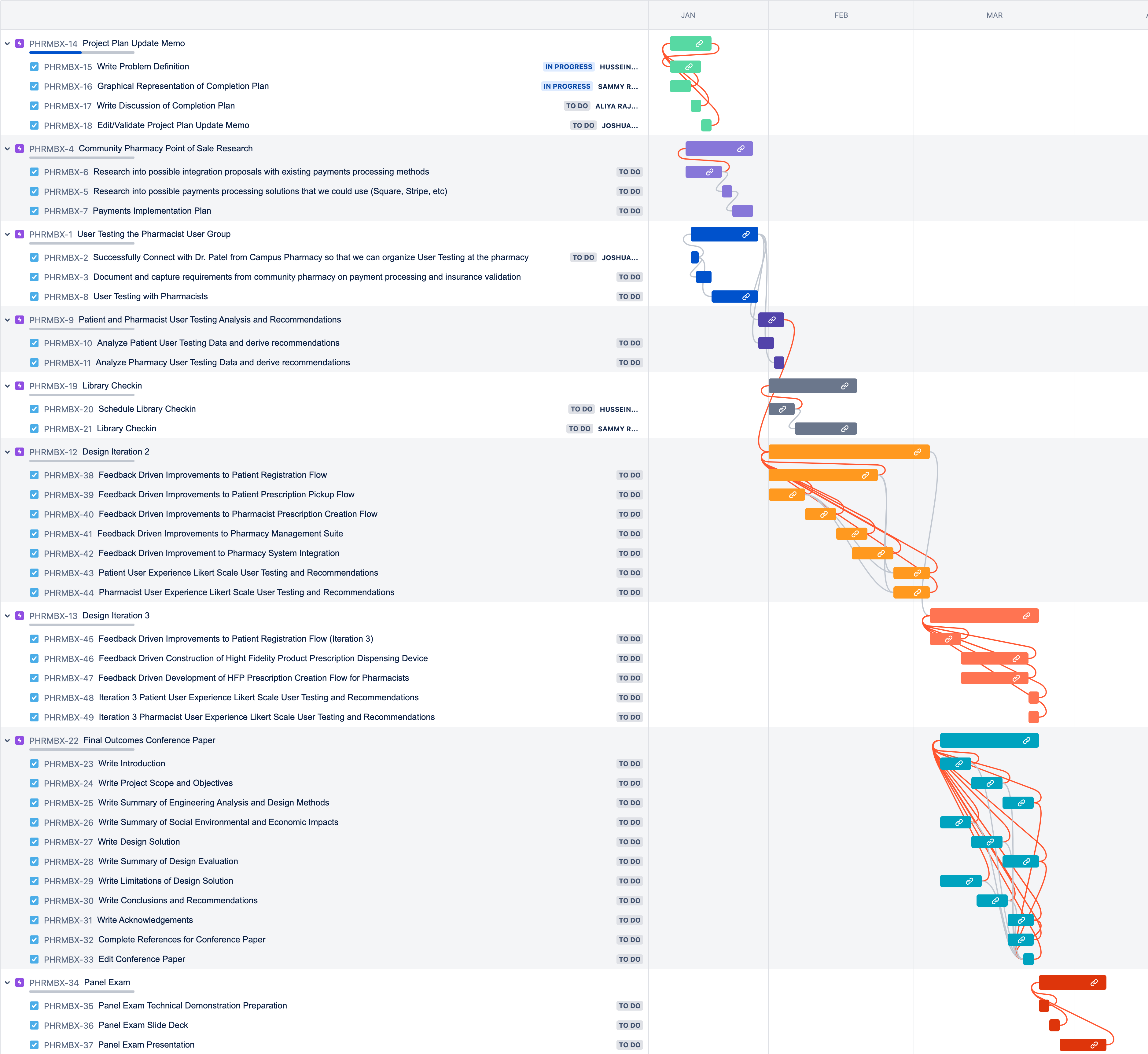SYDE 461 PharmaBox - Project Plan Update
Team 21: Sammy Robens-Paradise, Hussein Nagri, Josh Wilkinson, Aliya Rajwani. January 20th, 2023
- PROBLEM DEFINITION
The PharmaBox fourth-year design project addresses long wait times commonly experienced by patients at community pharmacies in Canada. These long wait lines are inconvenient for patients, shoppers, and pharmacists. Wait times negatively affect patient care because pharmacy staff are not able to spend sufficient time with patients, negatively impacting patient care. The main factors contributing to these problems are the shortage of pharmacists in Canada and the increasing need for prescriptions to keep pace with Canada’s population growth [1]. The lack of efficient service delivery strategies at pharmacies significantly contributes to these problems. If left unresolved, the long pharmacy wait times lead to negative consequences such as patients abandoning their prescriptions, resulting in health issues as well as prescription overload at community pharmacies [2].
To address the above challenges, our project is to design a platform that automates the prescription pickup process for repeat prescriptions, with the exception of drugs classified as schedule-I under the Controlled Drugs and Substances Act (S.C. 1996, c. 19) [3]. This will reduce time wasted by patients, pharmacists, and pharmacy technicians. By implementing a solution allowing patients to retrieve their repeat prescriptions without the need to interact with a pharmacist or pharmacy technicians, the service will reduce wait times at pharmacies and negative consequences such as prescription abandonment.
Our problem definition has evolved as we continue to understand more about the problem space, engineering requirements and constraints. At first, the problem was surrounding the unnecessarily long wait times experienced by individuals picking up prescriptions at pharmacies. Throughout the project, the definition has evolved to create an accelerated prescription pickup process to also save pharmacists, and pharmacy technicians time in addition to the aforementioned goal. We are now focused on learning more about pharmacies. This includes learning about what existing software systems they are using and how we can best integrate them into those used by pharmacies. It became clear that to address wait times, a solution would need to address both the needs of patients as well as pharmacy staff.
We have explored the stage of patient interactions with our initial prototype. We have done user testing with patients, and have collected feedback which will be analyzed to improve our current prototype. We are currently seeking to improve the experience for these patients through accelerated prescription pickup and reduce the cognitive load on pharmacy staff, optimizing the process of fulfilling repeat prescriptions by integrating our platform into pharmacy management software commonly used at community pharmacies. We are currently in the process of gathering additional information from the pharmacy on-campus at the University of Waterloo where we hope to collect insights about intra-pharmacy processes that will help us better understand challenges associated with integrating a platform solution into the community pharmacy workflow and optimize the repeat prescription pickup process.
- COMPLETION PLAN

Figure 1. Pharmabox FYDP Completion Plan, Winter 2023 [SRP, HN, AR, HW, 2023]
- DISCUSSION
Going forward, the project will consist of a higher-fidelity hardware prototype. Our goal is to also figure out if integrating our solution with pharmacy software is the best course of action, and if so, building the associated solutions that accompany this. To do so, we will be conducting user testing with pharmacies and analyzing our results to make data-driven decisions for our two future design iterations. We will begin by creating proposals for possible payment gateway integration strategies. Using this data, we will begin our second, followed by our third design iteration. In these design iterations, we will focus on making improvements to the different flows that exist in our system. For example, the patient prescription pickup flow and the pharmacy prescription creation flow. We aim to have completed 2 design iterations. Conducting user testing at pharmacies is dependent on when the pharmacy manager is available, and when the pharmacy is not too busy. To tackle this possible issue, we have decided to be flexible on which pharmacy we will conduct user testing and have created a mitigation strategy.
- REFERENCES
[1] Alodan A, Alalshaikh G, Alqasabi H, Alomran S, Abdelhadi A, Alkhayyal B. Studying the Efficiency of Waiting Time in Outpatient Pharmacy. MethodsX. 2020 May 13;7:100913. doi: 10.1016/j.mex.2020.100913. PMID: 32461924; PMCID: PMC7240714.
[2] Prescription Pickup Kiosks. [Online]. Available: https://www.japha.org/article/S1544-3191(20)30526-4/fulltext. [Accessed: 18-Jan-2023].
[3] L. S. Branch, “Consolidated federal laws of Canada, Controlled Drugs and Substances Act,” Controlled Drugs and Substances Act, 17-Jan-2023. [Online]. Available: https://laws-lois.justice.gc.ca/eng/acts/C-38.8/. [Accessed: 18-Jan-2023].